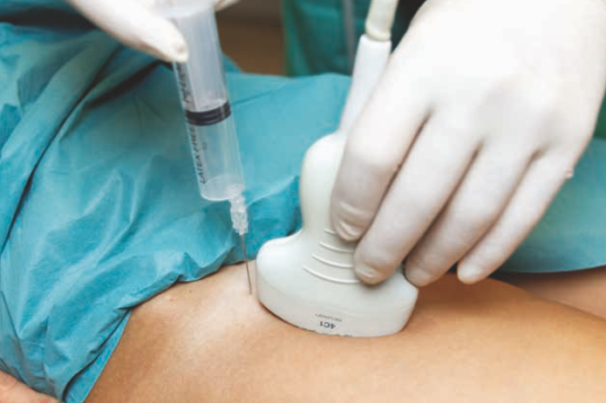
Ozone therapy: what it is, how it works and for which diseases it is indicated
Ozone therapy is a medical treatment based on a mixture of ozone and oxygen which has a pain-relieving, anti-inflammatory, antibacterial and tissue revitalising effect
Thanks to its many benefits, it can treat a wide range of ailments and diseases, from back pain due to herniated discs and protrusions to painful joint conditions such as arthritis and rheumatism.
Ozone therapy: ozone protects against UV radiation and is effective against bacteria, viruses and fungi
Ozone is a gas whose molecule is made up of three unstable oxygen atoms.
More than 90% of this gas is found in the stratosphere (a band of atmosphere approximately 10 to 50 km in height), where it provides an indispensable protective barrier against UV radiation generated by the sun.
But this is not its only important function. Ozone is also an effective bactericidal, fungicidal and virus-inactivating agent and, in the fight against Covid-19, has in fact been used to sanitise surfaces.
It is also naturally present in the human body. Produced by white blood cells, it is used by the body to defend itself against bacteria, viruses and fungi.
Finally, ozone has the ability to be halved in an aqueous environment, such as our bodies, in about 20 minutes.
This characteristic has led to this gas also being used in the medical field, mixed with oxygen.
The low concentrations of ozone used ensure that it disappears completely from our bodies in this time.
The benefits of ozone therapy
The administration of ozone produces numerous beneficial effects in our body. More specifically:
- it encourages the release of endorphins, the so-called ‘feel-good hormones’, which block the transmission of the harmful signal and release a feeling of euphoria;
- it has an anti-inflammatory action, since it acts
- increasing anti-inflammatory cytokines (protein molecules responsible for counteracting the body’s inflammatory response);
- reducing the quantity of pro-inflammatory cytokines (which feed inflammation).
- it optimises the link between the oxygen breathed in and the red blood cells (cells responsible for transporting oxygen to the tissues), thus increasing the supply of oxygen to the peripheral tissues with a consequent revitalising effect;
- it has an anti-ageing effect, as it encourages the activation of endogenous anti-oxidant mechanisms, i.e. those produced directly by the body (reduced glutathione and supeoxide dismutase), which counteract the action of free radicals;
- it has a lipolytic or ‘fat melting’ effect, as it is able to break down long-chain fatty acids;
- it has an analgesic action, important in terms of muscle relaxation and vasodilation and reactivation of muscle metabolism.
- It promotes the oxidation of lactate or lactic acid, thereby neutralising acidosis (high levels of acids in the body). In addition, a further analgesic effect is derived from the induction of antioxidant enzymes.
Ozone allows increased synthesis of adenosine triphosphate, the energy reserve of cells, which causes calcium reabsorption and consequently oedemas.
Finally, its oxidation capacity favours the destruction of capsules and bacterial membranes, giving ozone a marked antiseptic function, in particular
- bactericidal;
- virus-static, preventing infection of the cells and thus its replication.
How oxygen-ozone therapy works:
Oxygen-ozone therapy can be practised through different routes of administration, for each of which there is a specific concentration of the gaseous mixture, according to protocols drawn up by the Italian Scientific Society of Oxygen-Ozone Therapy (SIOOT).
The main methods of administration are
- intramuscular
- subcutaneous;
- rectal;
- intra-articular;
- intravenous.
An ally against many diseases
This therapy has a very wide range of application.
In particular, good results are achieved against pain and inflammation.
For this reason, the administration of ozone and oxygen is often used for the treatment of:
- painful diseases of the spinal column due to root compressions or disc protrusions;
- painful pathologies of the joints on an atroxic-degenerative basis;
- scars;
- skin adhesion phenomena;
- lipodystrophy, i.e. abnormal loss of body fat.
Good results are also obtained with this treatment in aesthetic medicine, particularly against cellulite.
Possible side effects
Patients generally tolerate the administration of ozone very well, provided it is administered by qualified doctors.
However, the patient may experience a feeling of heaviness and/or slight burning, which generally lasts for a short time and resolves spontaneously.
Rarely, the painful stimulus caused by the needle prick can lead to a vagal crisis with a drop in blood pressure, sweating and a reduction in heart rate.
Due to its transitory nature, this manifestation usually does not require any pharmacological treatment.
Oxygen ozone therapy does not cause allergic reactions, as the gas used consists solely of oxygen atoms.
However, there are some complications that are linked to the use of needles for administration, such as
- haematomas, following the accidental puncture of a blood vessel;
- pain or tingling sensation/electrical shock, due to accidental pinching of a nerve’.
Contraindications
The following are considered contraindications to oxygen ozone therapy, especially intravenous oxygen therapy:
- pregnancy;
- clinically manifest hyperthyroidism
- favism;
- epilepsy;
- severe cardiovascular and/or haematological and/or respiratory diseases in clinical decompensation;
- the need to undergo surgery that cannot be postponed.
Read Also:
Diagnostic Imaging May Increase Risk Of Testicular Cancer: A TGCT Study From Pennsylvania
Cardiac Arrest Defeated By A Software? Brugada Syndrome Is Near To An End


